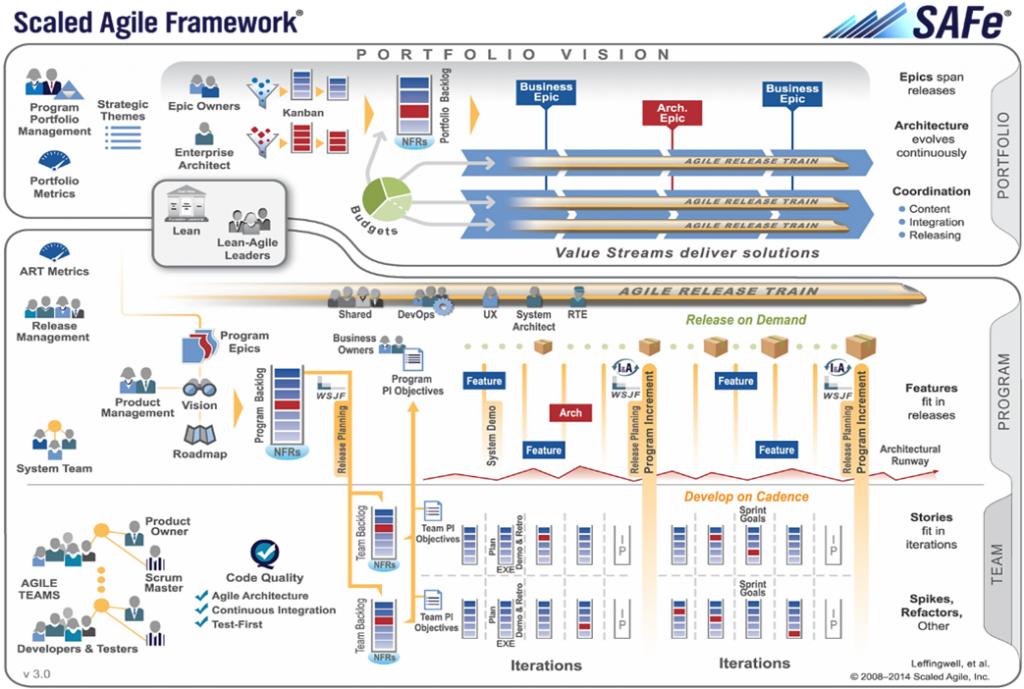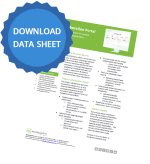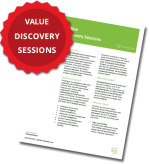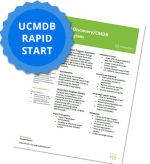What Is Scaled Agile Framework, and Why Is It Important?
By: Matt Angerer
The way in which IT projects are designed and completed has changed significantly since I started working as an IT practitioner at Verizon in 1999. Fast forward 16 years and a lot has changed. I remember taking MIS 204 at Penn State University and learning about the Systems Development Life Cycle (SDLC). The entire class was centered upon the Waterfall (Traditional) approach to software delivery and I don’t recall any mention of Agile principles. Most of my career was spent working on large-scale ERP implementations (e.g., SAP for the U.S. Army or Defense Logistics Agency) and even larger-scale .NET projects for State Agencies. Imagine how structured and formalized those IT projects had to be? For the DoD projects, an IV&V (Independent Verification & Validation) function was required for any projects over $1 million in revenue. For those who aren’t familiar, IV&V is an oversight of the Delivery Teams — basically double checking all the work and reporting out observations.
Now that the world appreciates and recognizes the value of Agile principles for software delivery, a number of challenges naturally present themselves in the form of overall control. With so many developers involved in large-scale implementations, how can you fit everyone into a small pod at the office with your Scrum Master spouting off those 3 questions? Well, the short answer is that you cannot. Your development and QA team are likely decentralized, contracted, and experience turnover. What’s more, some of these “big projects” take years to complete from start to finish, are highly complex, and never truly finish. Originally, Agile was spun up to help facilitate small teams and it worked well. Scaling it to large teams has led to this new approach, otherwise known as SAFe.
The Need for a New Approach to Development
According to the World Quality Report, approximately 93 percent of organizations are now using agile development methods. That is compared to only 87 percent of organizations that used such methods in 2013. However, many of those organizations continue to face challenges with their testing approach. Taken singularly, HP Agile Manager might not be the best tool to manage your Quality Assurance (QA) and testing efforts. If you look at this tool in the context of how it fits with HP Application Lifecycle Management (ALM), Unified Functional Test (UFT), Sprinter, and Performance Center (PC) — the picture suddenly changes for the better. Working together, as software tools should, these powerful products help facilitate a sound quality assurance approach across each testing layer.
The “Portfolio Vision” of HP’s products also helps you understand how the scaled agile framework operates as a system, emphasizing cross-functional teams over processes. In the past, agile methodologies came to a halt at the team level. With a scaled agile framework, teams are typically much smaller and presented with all of the tools necessary to complete software in an end-to-end fashion. This includes coding, testing, and deployment.
Generally, multiple teams may create what is known as a release train, centered on a single program. HP Agile Manager was designed from the ground up to support the Scaled Agile Framework as depicted below. What’s more is that embedded technology in Agile Manager like ALI (Application Lifecycle Intelligence) allows your team to connect into Source Code Management (SCM) repositories and Build Controllers. This give your Product Owners code-level visibility into Themes, Features, and User Stories, with HP releasing many free add-ons for your developers favorite IDEs like Eclipse, IntelliJ, and Visual Studio.

The Benefits of Scaled Agile Framework
A scaled agile framework offers a number of benefits. It becomes possible to achieve project alignment in a variety of ways, including at the portfolio level. Here, architects and portfolio managers collaborate to design a map for completing the final project, ensuring that projects don’t grow out of control. Yet another benefit offered by scaled agile framework is higher-quality software, which to me at least, is far more valuable than alignment.
The scaled agile framework approach makes it possible to combine excellent software engineering practices with best practices in process management to ensure a focus on quality throughout a project. One example is called test-driven development, which involves writing the test prior to writing the software. This approach allows you to conceptualize the code before writing it, meaning fewer problems that could impact project quality.
Another aspect of SAFe worth mentioning is your tools strategy around Agile and Quality Assurance. As mentioned previously, HP Agile Manager might not be the only tool you use for test planning or manual test execution. Its native integration with HP ALM and Quality Center (QC) allows Scrum Masters and Product Owners excellent visibility into the test execution progress of a given sprint or user story.
Built into Agile Manager is a way to prioritize for roadmapping with the Weighted Shortest Job First (WSJF) concept. By enabling WSJF within HP Agile Manager, you tell the tool to score a features priority based on the Cost of Delay (COD) and remaining job size. Basically, this helps you look at the “overall picture” of all the features across the organization. Setting this up within Agile Manager is a simple equation:

Sign up for a free trial of HP Agile Manager today with the ResultsPositive team.
Subscribe for the latest RP Blog Updates:










